
Pat Racco
Founder of Advantage Media
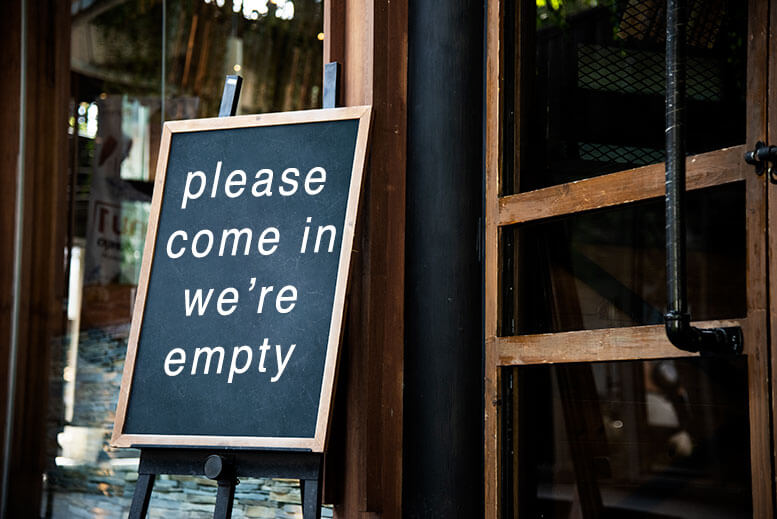
So you have a marketing plan, a strategy, and a vision. And maybe you paid a sh* load of money to a branding agency, because, you know, “branding is everything” the branding agency said.
Yes, these are the steps to take, if you want yours to be an average hospitality business.
It is not enough to invest in interior design to have an identity, as it is not enough to have a website and a Facebook and Instagram page. In the digital era, a lot is going on right now.
Hospitality marketing has never kept people this busy. The digitalisation has changed the way people choose what they eat and where they accommodate: it is now said that more than 50% of the population book flights and hotels online, not to mention restaurants.
Through GPS, they choose the “closest” restaurant based on reviews and rely on facilities with a healthy brand reputation. The potential customer wants to know the menu, the opening times, the chef, look at the photo of the dishes, the furniture and, perhaps, book a table via an app.
Digital is an opportunity for growth and innovation for the hospitality industry. We must not distort the relationship with the customer, but modernise the channels and methods of communication. “It’s web 2.0, baby”.
What to do to bring customers to your door
I’m Italian and passionate about cooking, indeed, to tell the truth, I love eating what others cook.
Yes, things done with love are undoubtedly nice, but to cook well, it takes a lot of talent and years spent studying behind the stove. It is not enough to draw a little heart with the sauce on the pizza to make it tasty.
I often go to try new restaurants, both in Australia and Italy and sometimes I discover real pearls of flavour. Dishes that have nothing to envy to those of the most famous restaurants, but where diners are scarce.
People are crazy about food, not just when they starve, but in general. There’s an intimate connection between our soul and the taste of food. It’s something tattooed in our DNA, and there’s not much we can do: we’ll always eat out. We’ll always be seeking the next dining experience as well as we’ll always hear about the next MasterChef season, whether we like it or not.
I’ve been asked to write an article on how to improve restaurant marketing. Honestly, I wasn’t intrigued. But once, while working as a consultant for Visco Foods, I wrote an article about food that went on Google page 1 in a week, skyrocketing the traffic to their website!
But what if everyone applied my strategies? It would be a mess: all the unknown locals that I love would have people lined up, and I’ll have nothing left to brag about.
This, at least, is what I thought until recently. If I am now going to reveal the secret techniques of hospitality marketing it is only because of my two recent discoveries:
- Research conducted at the Harvard School of Economics claims that only 5% of people who know the secrets of marketing apply them in their businesses because practical examples are missing.
- The official figures speak of 85 thousand restaurants and fast foods in Australia. It’s the double of Italy in terms of the density of restaurants pro capita. Consider that In Italy, it’s said that there are more restaurants than saints!
Think then, that of those born in recent years, 45% cannot last for more than three years and are replaced by others. Well, at least there are lots of new places to try…
But this also means that unfortunately many do not make it.
I’m sure that opening and managing a restaurant or hotel is difficult and risky, but I believe that in many cases the problem lies in the marketing.
Of course, one cannot know how to do everything: if one is good in the kitchen, he or she may not necessarily be good in hospitality marketing. However, without a good strategy, customers will never come.
Things were already difficult in the pre-hipster era, but now that everyone has a long beard, a Twin Peaks lumberjack plaid shirt and folded trousers (as if they all had a flooded house), it’s getting harder.
The problem is not the bearded ones (like me), but the pace of the web, which make the marketing of a restaurant even more complicated.
Yes, it’s more challenging to keep up with the digital trends, but it’s much easier to attract paying people from every corner of the planet, even in Pedesina, in the province of Sondrio (Italy), where only 33 people live.

Here are the best marketing strategies for restaurants divided by section; first the obvious ones, those for beginner egg boilers, then the intermediate ones for those who manage to perfectly cook a Lava Cake, the volcanic chocolate pie and finally the “pro” ones, for starred chefs who would be able to combine cod and strawberries in a spectacular way.
How to attract customers to a restaurant with marketing
HOSPITALITY MARKETING - OBVIOUS STRATEGIES
The basics of marketing for the hospitality industry
- Create a website for your restaurant. No further comment. Do it with WordPress and drop all offers to make a free blog or website (see GoDaddy). Spend that extra amount, and you will be rewarded.
Choose a fast hosting for WordPress like WP Hosting. They’re my favourites, I work with them and their support is awesome.
How much should you invest for hosting your site? Considering the domain, a good hosting service and a SSL certificate (security first, then branding!), I would say at least $500/year. Much more (sometimes even ten times as much) if you consider the (usually winning) idea of relying on a professional for your website. Take a look at my web design service page to get an idea of what you need! - Web indexes. Make sure you are present on most business indexes and services such as Yellow Pages and Tripadvisor, which are consulted daily by avalanches of hungry beasts that could spend their pennies on you.
- Make good SEO. If you have a wholesale foodservice distribution business, make sure you are at the top of the list for the keyword “wholesale food”. Speaking of keyword research, Ubersuggest is one of the best tools for finding the right keywords.
You must develop organic traffic through content. It is more of a marathon, but it will only cost you time. - Make some online advertising. Sore point: here, we have to invest. Well, it’s not just about throwing money to Mark Zuckerberg’s face and say: “Gimme the traffic.” Advertising is a science; it’s math and magic combined.
- Social Media. Curate a profile on the major social media networks. Here, in reality, we are borderline with the next marketing techniques for restaurants.
HOSPITALITY MARKETING - INTERMEDIATE STRATEGIES
The launch or re-launch of your activity passes from these points
- We were saying: create a social profile on the major networks, like Facebook, Twitter, Instagram, Youtube and if you also want Snapchat. It depends on the personality of your place: an elegant restaurant near the Opera House is not suitable for a saucy vernacular. A website and a Google My Business profile might be enough; I’ll explain why soon. On the contrary, a vegan sandwich for young people can be pushed big on carefree networks like Snapchat, while a place for intellectuals or artists could do very well on Twitter.
- In any case, create a Google My Business profile as detailed as possible: people looking for your “wholesale foodservice distribution” might find this:
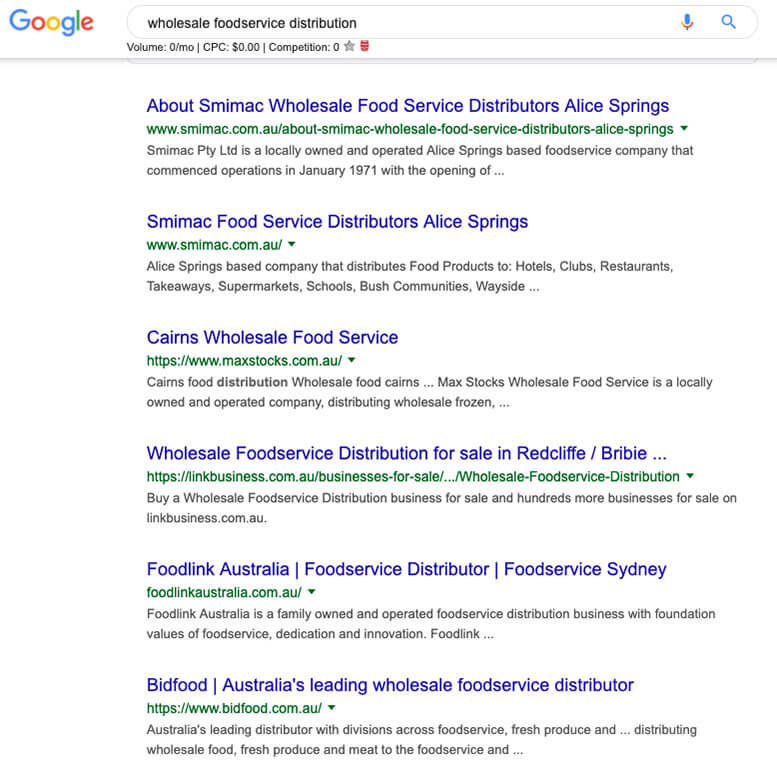
See what happens instead if you are a Google My Business member:
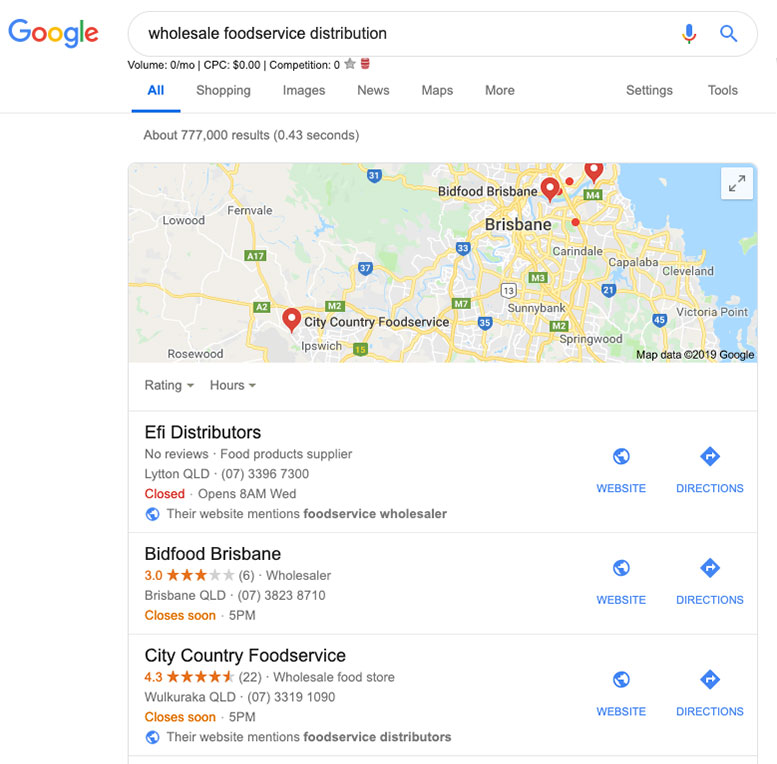
These “little” things improve the user experience and give you more customers!
- Let’s close the intermediate category with marketing ideas for restaurants that are perfect for the web: make sure to make available some information about your restaurant, those that everyone is looking for and that they don’t always find. Know that someone like me, who is looking for the opening times of your restaurant and can’t find them, don’t forget.
HOSPITALITY MARKETING - MICHELIN STARS STRATEGIES
Empathise with the public = Success is guaranteed
- Post photos of your dishes on social media. Everyone does it and it’s painful, but for you, it’s different: you live your dishes. So let them know how beautiful and good they are, it’s not a sin, but a smart move.
If you can make videos, then you can publish them on Youtube and optimise them for specific keywords.
Here is an example of good restaurant marketing:
I was at La Dolce Vita in Milton, when Kerin came with a birthday cake that Gaetano’s brother made for her. Gaetano is the pizza maker at La Dolce Vita. The cake was an incredible maxi cannolo cake that wrapped 30 regular cannolis on its inside. I took a picture and posted on Facebook. That one was the most successful post La Dolce Vita has ever shared, way more than showing the Broncos (and their bus) or the Brisbane Roar dining there! And we all know how hard it’s to get that spoiled bi*c (Facebook) to show our stuff to people.
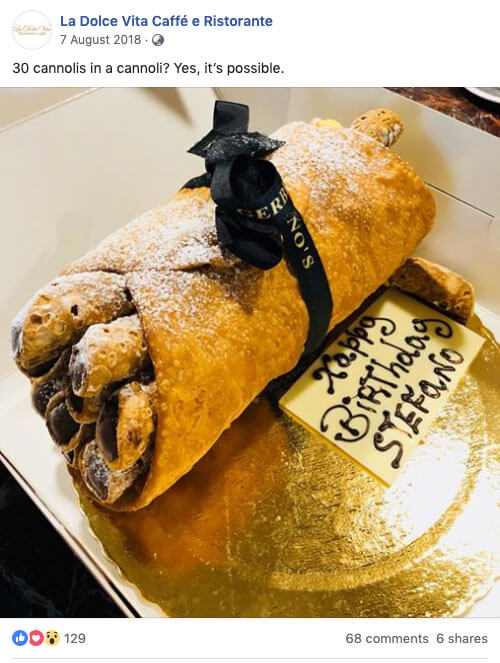
Not bad for a small local business.
And finally, every time you add a dish to the menu, let them know on social networks with a nice description and a short caption. People want to know. They need this. My wife drags me from place to place because she must try that thing she saw on Instagram.
- Publishing photos of your dishes is a good hospitality marketing strategy for restaurants and hotels for youngsters, but also for food suppliers in search of new clients!
Ok, you want to know how, when, where, why. Well, try not to use your Nokia 3310 to take a 1-megapixel photo. A modern smartphone is enough. But if you happen to get to know some fans, offer them a dinner in exchange for some good pictures on their social media (so you can share them)! You have to be active on social media, so why not running an offer like this: a dinner for a photo? Why not hold a competition? Who publishes the best photo of my calamari wins a dinner for 2! Come on, don’t be a stingy guy!
Please note that, from this point on, you become a hospitality marketer. Whether you outsource or DIY, it should become part of your daily job; and I’m sure you don’t like people saying you’re doing a bad job.
- Point # 1: when? Well, I’ll tell you a secret: the best time of the day to post on Facebook or your blog goes from 9 am to 11.30 am on weekdays, especially on Tuesdays, Wednesdays and Thursdays.
- Point # 2: where? Facebook is a gold mine if you use it well, but it can also be costly. It’s a tremendous social network primarily for sharing your customers’ photos. Unlike your Facebook page posts, your customers’ photos cost nothing and can reach all their friends! If you ask them to enter the geotag, you have a free link to your restaurant.
- Point # 3: why? Come on, do I really have to tell you? We all know how food photos work. Eating is a fundamental need, and every reference to food erotically attracts us. Think of all those in the office and at 11 am who have their stomachs crawling sounds only Marilyn Manson could replicate. They open Facebook in secret and look for “sandwich shop for lunch break in South Bank”. Your site is out, complete with a Google My Business profile and photos of a double cheeseburger with stringy cheese, onions and chips that drown in a ruthless barbecue sauce. Very, very hot.
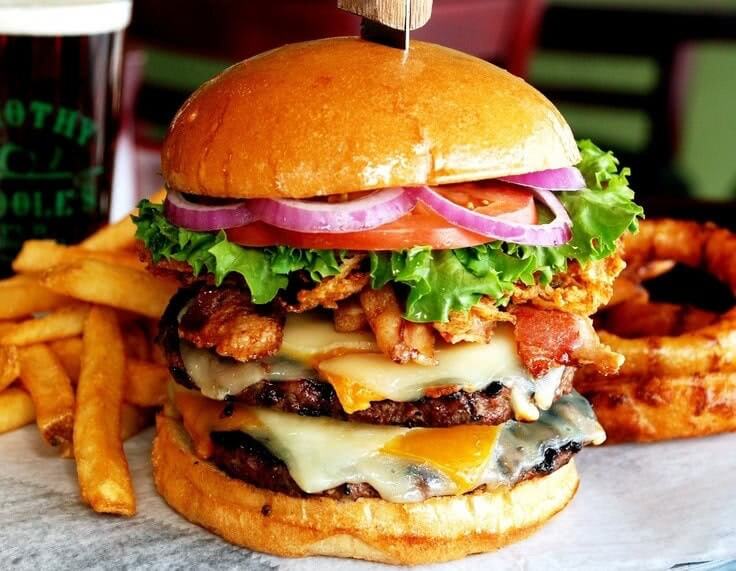
- Humanise your staff. Make your staff protagonist for a day on your blog or social media; you won’t regret it! How you do it? Well, using the magical power of storytelling.
- Influencers. This word, so terribly tawdry, is one of the ingredients of marketing success for your restaurant and should be included in your hospitality marketing mix. The name of your business must be on everyone’s mouth before your dishes. With “influencer” we do not mean only the famous people, but all those who have the power to bring audiences to you. Agree with food bloggers, contact PR and public figures very popular on the web, especially local ones. Do you know a DJ who has 10,000 friends on Facebook and could attract thousands of people? Well, ask them to post a photo of lunch with you in your place. You don’t know him, but you do know how to contact him. Offer him lunch, dinner for two, or money
- Consistency. The identity of your place must be well defined, and all the marketing choices you make must be closely linked to your branding. Therefore, if you focus on a young and posh clientele, make sure all your strategies are consistent. Post photos and stylish stuff, give your dishes an original name and point out your attention to detail. If instead, you are a traditionalist, put the white and red checked tablecloths in the foreground and focus on the substance!
- Limited offers. You must exploit the sense of urgency, a certain psychological technique. Put quinoa, salmon and avocado on a plate, present it well, take a picture of it and throw it on Instagram with a daily offer only valid for those who share it.
- Do you deliver food? The new frontier of the web is to have dinner brought home with a click. Just so you know, they will suck all your profit, but if you still want to join the toxic trend, signup to all the services available online, like these (enjoy the 35% fee):
- deliveroo.com.au
- ubereats.com
- foodora.com.au (it’s been shut and drowning in debt)
- Go all-online. As I already told you in the “obvious strategies” category, make sure that your client’s online experience can be comprehensive and complete. Make sure that from your site you can:
- make a reservation
- access the menu including the wine and the day specials
- visit the venue (virtually), at least through a video or photo of excellent quality
- understand the style and personality of the restaurant (the details are fundamental: what kind of music is there? Turbofolk in rave party volumes like the best trash locals in Belgrade or lyric venues like the Ritz?
- access the toilets. Well, at least let everyone know if it is clean, large, equipped, discreet, fragrant, suitable for the disabled and the elderly? Tell everything, for God’s sake! These are the most sought after and crucial information for many people!
- know if it is appropriate to take the children with them or to lock them up in a cage of coloured balls in some parking place for kids. I have a daughter and I can tell the temptation is big…
- ALLERGIES and INTOLERANCES! I write it in capital letters because today it is essential to say explicitly if your foods are gluten-free, palm oil free, sugar-free, yeast-free, hydrogenated fat-free, colourings-free, preservative-free, taste-free. If you offer some special menu and don’t advertise it, you shoot yourself in the foot.
- Ingredients: we have just talked about it. When transparency allows seeing the wonders of a restaurant, must always be a priority. If your kitchen is as clean as a neurosurgeon’s hands, let it be known. If your ingredients come only from nearby organic farms, make it known to everyone with photos, posts, videos, interviews, tastings, events, trips, excursions.
- All mobile. It is version 2.0 of the “all online” rule. You have to identify yourself with one of your possible customers and make sure that all your services are not only online but also optimised for mobile smartphone versions. Create your app if you have cash, but above all optimise your site!
- Loyalty. I always go to the cafe to drink coffee, not only because it’s delicious and because the bartender is nice … but also because I never pay. Yes, the guys from La Dolce Vita are generous with me. It’s like family. However, when people ask me where to eat, I always recommend them. As I said a few lines ago, try to get an app that rewards the loyalty of your customers! Engage them with special offers and a captivating newsletter, where you report the events, news and promotions reserved for loyalists. Every few drinks reward your customers: do you know how nice it is for a diner to receive a bottle of wine or a dessert on the house?
- Host it. Can your venue host concerts, exhibitions, events, presentations, discussions, installations, theme nights? Become a social and cultural reference point, and you will have a line in front of the door. An idea? Organise a cooking course in your restaurant: show some of your recipes as a reward or in exchange for a small fee. Organise tastings and workshops: people want to be interactive, and interactivity is a guaranteed successful tool! Then spread the word through social media. This is a really effective hospitality marketing technique.
- For new businesses: choose a short and evocative name. Tip: a name consisting of a single word, a maximum of 7 letters. Why? It is a fact of human memory, that is also very well suited when choosing a domain for your website.
- Choose a logo that is both coherent and professionally designed.
If you know someone who might find this article useful, share it. Thank you!
